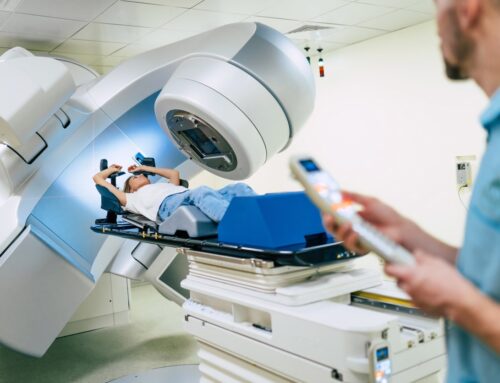
Bowel Issues Related to Cancer Treatments
Bowel Issues Related to Cancer Treatments
Bowel issues such as constipation are very prevalent in cancer patients due to the cancer treatments they are receiving. Constipation in advanced cancer patients ranges between 40% and 90%,¹ and is more common in opioid-treated populations.² Prevalence of constipation in cancer patients in intensive care units, veterans’ hospitals, and hospice home care range from 43% to 80%.3 Additionally, in older cancer patients receiving palliative care, constipation is one of the most prevalent symptoms, with prevalence rates ranging between 51% and 55%.⁴
Rome IV Criteria for Constipation
The Rome IV Criteria for Constipation was developed in the 1980s and has been updated in recent years.
The criteria process evaluates a patient’s bowel habits and establishes treatment options from that point. The criteria require a patient to experience two or more of the following symptoms over the course of three months⁵:
- Fewer than three spontaneous bowel movements per week
- Straining during at least 25 percent of the bowel movements
- Lumpy or hard stools at least 25 percent of the time
- A sensation of incomplete evacuation of at least 25 percent of the bowel movements
- A sensation of obstruction or blockage for at least 25 percent of bowel movements
- Manual maneuvers to help at least 25 percent of bowel movements
The main criterion for chronic constipation is that the symptoms have persisted for more than three months⁵.
Criteria for Constipation Assessment Scale
The Constipation Assessment Scale (CAS) is an eight-item three-point rating scale that measures the presence and intensity of constipation.
Each item is rated by the patient as no problem (0), some problem (1), or severe problem (2). The items on the scale include⁶:
- Abdominal distention or bloating
- Change in amount of gas passed rectally
- Less frequent bowel movements
- Oozing liquid stool
- Rectal fullness or pressure
- Rectal Pain with bowel movement
- Small stool size
- Urge but an inability to pass stool
Factors Related to Constipation Among Cancer Treatment Patients
Among cancer patients, common precipitating factors may be classified as organic or functional. Organic contributing factors commonly include medications (especially opioids, vinca alkaloids, 5-HT3 antagonist antiemetics, iron, and antidepressants), metabolic aberrations (particularly dehydration, hypercalcemia, hypokalemia, and uremia), neuromuscular dysfunction (autonomic neuropathy and myopathy), structural issues (abdominal or pelvic mass, radiation fibrosis) and pain7.
Functional factors would include age, diet, and environmental factors like lack of privacy when toileting⁷.
Treatment Related Causes of Constipation
There are numerous treatment related causes of constipation including⁸:
- Opioid Analgesics – delayed gastric emptying and increased bowel transit time
- Serotonin 5HT3 Receptor Antagonists – slow colonic transit time
- Vinca Alkaloids – prolonged GI transit time
- Thalidomide – constipation is common
- Other Constipating Medications Used in Cancer Care
- Antidepressants
- Antacids
- Antispasmodics
- Anticonvulsants
- Antihypertensive Drugs
- Iron Supplements
- Diuretics
Fecal Incontinence After Rectal Cancer Treatment
Another prevalent bowel issue related to cancer treatments is fecal incontinence after rectal cancer treatment.
Fecal incontinence occurs frequently after rectal cancer treatment, affecting almost half of patients with normal preoperative functioning. Incontinence may range from inadvertent gas to minor soiling or complete rectal emptying and can lead to avoidance of certain activities, such as long-distance travel by car or plane, during which bathroom facilities may not be immediately available⁹.
Studies have indicated that following a traditional restorative resection, the most frequently reported symptom was fecal incontinence (97%)¹⁰. Taking a daily enema at consistent times will help control stool removal and decrease episodes of fecal incontinence¹¹.
Bowel Preparation for Prostate Radiation
When it comes to prostate radiation, rectal distention is the single most important variable in causing prostate motion in the anteroposterior direction¹². Patients receiving radiotherapy to the prostate can exhibit prostate shifts owing to rectoral distension that can lead to geographical miss¹³.
Fiorino et al showed the use of daily enemas for evacuating the contents of the rectum efficiently minimized prostate motion¹⁴.
Using ENEMEEZ® for Bowel Issues Related to Cancer Treatments
ENEMEEZ® mini enemas can benefit patients undergoing cancer treatments. ENEMEEZ® functions as a hyperosmotic stool softening laxative by drawing water into the bowel from surrounding body tissues, helping to soften and loosen the stool.
It is effective for bowel care needs associated with spinal cord injury and disease, MS, TBI, Spina Bifida, long-term care, stroke, and general constipation.
While ENEMEEZ® may be more expensive than other constipation solutions, as seen in the chart below, patients do not get mucosal discharge and virtually no fecal incontinence that is seen with Bisacodyl products. Additionally, ENEMEEZ® helps to preserve the skin integrity for the patient and reduces time spent by the staff cleaning up the discharge that occurs from the Bisacodyl.
About Quest Healthcare, A Division of Quest Products LLC
Quest Healthcare, is focused on medicines that change lives, pursues integrity and humanity, and strives to build a team that passionately pursues excellence.
Quest Healthcare provides an extensive network of information to assist healthcare providers in their pursuit to provide superior care for their patients and loved ones.
Disclaimer: The material contained is for reference purposes only. Quest Healthcare, A Division of Quest Products, LLC, does not assume responsibility for patient care. Consult a physician prior to use. Copyright 2022 Quest Healthcare, A Division of Quest Products, LLC.
Sources:
- Van Lancker A, Velghe A, Van Hecke A. Prevalence of symptoms in older palliative cancer patients: a systematic review and meta-analysis. J Pain Symptom Manage 2014; 47: 90–104.
- Canty, 1994; Robinson et al, 2000.
- Hoekstra et al., 2006; McMillan, 2002; McMillan & Rivera, 2009; McMillan, Tittle, Hagan & Laughlin, 2000; Tittle & McMillan, 1994.
- Larkin PJ, Sykes NP, Centeno C. The management of constipation in palliative care: clinical practice recommendations. Palliat Med 2008; 22: 796–807.
- https://theromefoundation.org/rome-iv/rome-iv-criteria/
- https://www.ncbi.nlm.nih.gov/pmc/articles/PMC5385997/pdf/nihms832060.pdf
- Dukas L, Willett WC, Giovannucci EL. Association between physical activity, fiber intake, and other lifestyle variables and constipation in a study of women. Am J Gastroenterol 2003; 98: 1790–1796. 18. Winge K, Rasmussen D, Werdelin LM. Constipation in neurological diseases. J Neurol Neurosurg Psychiatry 2003; 74: 13–19
- Annals of Oncology Clinical Practice Guidelines Volume 29 | Supplement 4 | October 2018 doi:10.1093/annonc/mdy148 | iv113 reabsorption and increased sphincter tone
- Hendren SK, O’Connor BI, Liu M, Asano T, Cohen Z, et al. (2005) Prevalence of male and female sexual dysfunction is high following surgery for rectal cancer. Ann Surg 242: 212-223.
- https://www.ncbi.nlm.nih.gov/pmc/articles/PMC6732333/pdf/ac-2019-08-10.pdf 6. Hayne D, et al, Anorectal injury following pelvic radiotherapy. Br J Surg 88: 1037-1048.
- . https://my.clevelandclinic.org/health/diseases/14574-fecal-bowel-incontinence
- Pinkawa M, et al. Influence of the initial rectal distension on posterior margins in primary and postoperative radiotherapy for prostate cancer. Radiother Oncol 2006;81: 284–90. doi: 10.1016/j.radonc.2006.10.028
- Beard CJ, et al. Analysis of prostate and seminal vesicle motion: implications for treatment planning. Int J Radiat Oncol Biol Phys 1996;34:451–8.
- https://www.redjournal.org/article/S0360-3016(08)00223-X/fulltext







